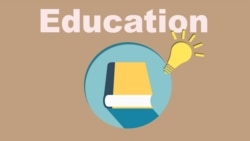A majority of Americans say they are not satisfied with the nation’s education system. They also have little hope that public schools will improve anytime soon.
That information comes from a public opinion study released earlier this month.
John Della Volpe directed the poll for RealClear Politics. The poll asked registered voters about their thoughts and expectations of K-12 education. K-12 schools are kindergartens, elementary and secondary schools.
Volpe told VOA that Americans have major concerns about the quality of K-12 schools.
"And they expect and will soon be demanding more from elected officials at all levels of government.”
Volpe says the majority of voters believe the current education system is performing “only fair or poor.”
Only a small number, eight percent, say it is excellent.
People do not have a lot of hope for improvement, either. Most people answered that they do not think American schools will be a model for the world in the next 20 years.
The United States, Volpe says, has “a long way to go in order for us to lead the world in quality education.”
U.S. public schools
Public schools in the U.S. provide education from kindergarten through 12th grade. They are generally free for students. Each of the 50 states manages its own public school system.
Financial support for public schools comes from state and local governments. The federal government provides a small percentage of the money needed, too.
Much of the money comes from local property taxes. So, there are often differences between schools in wealthier neighborhoods and those in poorer areas.
Volpe said people’s beliefs about their schools are “highly” connected to how much money they make.
“You are three and a half times more likely to…believe you are in a good school district or that education will be better in the future and a standard for others to follow if you come from a household who has income of $150,000 or more, relative to those who earn less than $50,000.”
Because of this, he says, there is “a rising sense of not only economic inequality in this country but educational inequality.”
What do Americans expect from their schools?
The researchers asked study participants what they want public schools to provide children. The participants chose from a list of 15 possible priorities.
The top answer? Schools should teach students to read and write. Next was to teach them to be “good citizens.” The third-most important priority was to keep students “safe from violence and physical harm.”
Preparing students to “enter the workforce” and giving them “knowledge of American history” came in fourth and fifth.
Only about half of the participants said schools should prepare students for college. That choice came in 13th.
In a time of great political division in the U.S., Volpe says, education is an exception.
“K-12 education is one of very few issues where partisanship and ideology is not a major factor or a major driver.”
People from both major political parties agree that the education system needs improvement. Fifty-one percent of Republicans and 55 percent of Democrats rate American education as “only fair” or “poor.”
K-12 education is an important issue to voters. But it has not received much attention so far in the 2020 political election cycle.
Instead, politicians have debated about higher education, such as whether colleges and universities should be free.
Volpe says the poll shows that education is an issue that will be important in 2020.
“I think the politicians and the candidates are not making (education) a priority. But I'm not sure that people are accepting that or will accept it any further. It is a top priority, and I think it can make a difference between candidates in the Democratic primary or certainly in the general election.”
I’m Anne Ball.
Anne Ball wrote this story for Learning English. Ashley Thompson was the editor.
How is K-12 education viewed in your country? What do you think of this story? Write to us in the comments section below.
________________________________________________________________
Words in This Story
poll – n. an activity in which several or many people are asked a question or a series of questions in order to get information about what most people think about something
key – adj. extremely important
status – n. the position or rank of someone or something when compared to others in a society, organization, group
school district – n. an area or region containing the schools that a school board is in charge of
standard – n. a level of quality, achievement, etc., that is considered acceptable or desirable
inequality – n. an unfair situation in which some people have more rights or better opportunities than other people
priority – n. something that is more important than other things and that needs to be done or dealt with first
partnership – n. the state of being partners
factor – n. something that helps produce or influence a result : one of the things that cause something to happen













